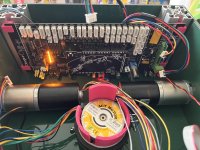hotchiguy
New member
Hello,
I have just finished the kit assembly (brushless motors, GPS RTK)
After I've connected all the components to the board, I've plugged in the battery but nothing turned on.
I found out that EF2 wasn't conducting anymore, so I replaced it and re-plugged everything - I saw a short blink of the 24V LED but then the fuse was blowned again (
(
I've re-soldered new fuse. I can power up the board with Arduino, 9V regulator just fine - see the attached picture.
Seems like whatever left to connect - such as motors, motor driver, gps, esp32, ultrasound sensors - causing a short circuit.
I would really appreciate if anybody has an idea on what is likely the cause or how can I test individual connections without keep blowing the fuses - I only have few more left.
I have just finished the kit assembly (brushless motors, GPS RTK)
After I've connected all the components to the board, I've plugged in the battery but nothing turned on.
I found out that EF2 wasn't conducting anymore, so I replaced it and re-plugged everything - I saw a short blink of the 24V LED but then the fuse was blowned again
I've re-soldered new fuse. I can power up the board with Arduino, 9V regulator just fine - see the attached picture.
Seems like whatever left to connect - such as motors, motor driver, gps, esp32, ultrasound sensors - causing a short circuit.
I would really appreciate if anybody has an idea on what is likely the cause or how can I test individual connections without keep blowing the fuses - I only have few more left.


